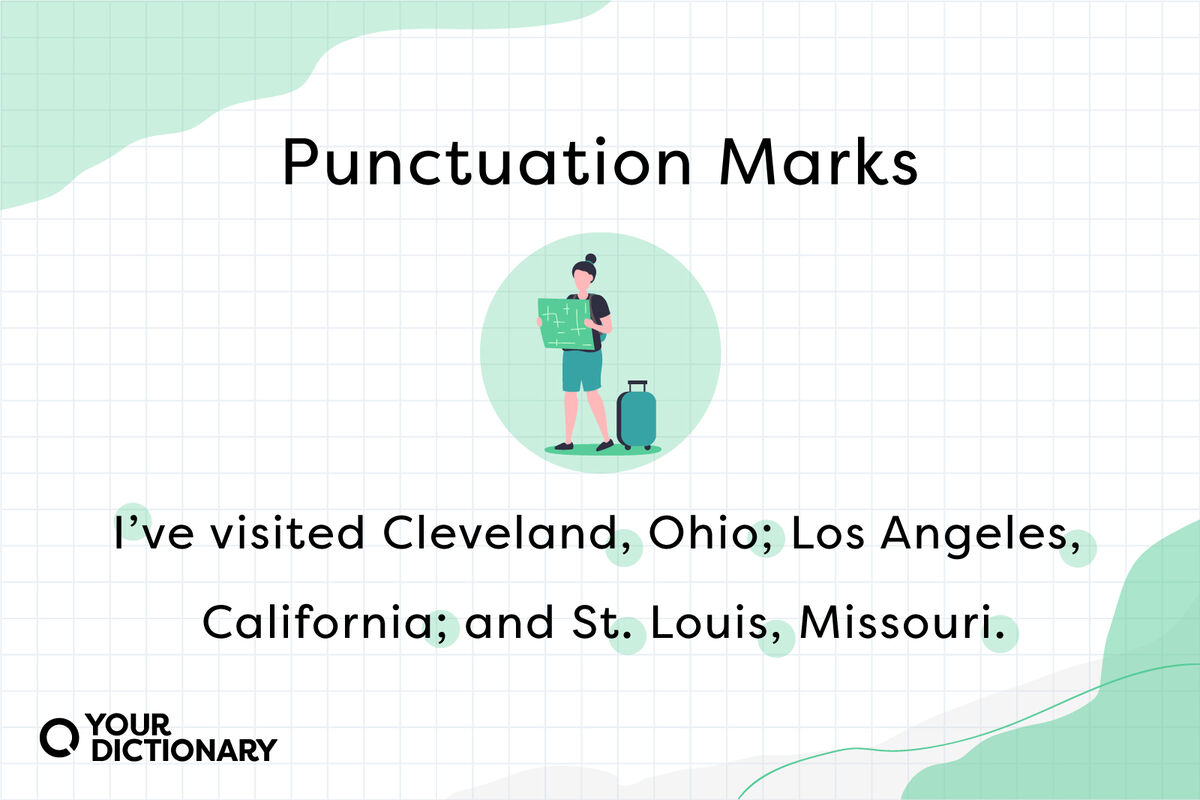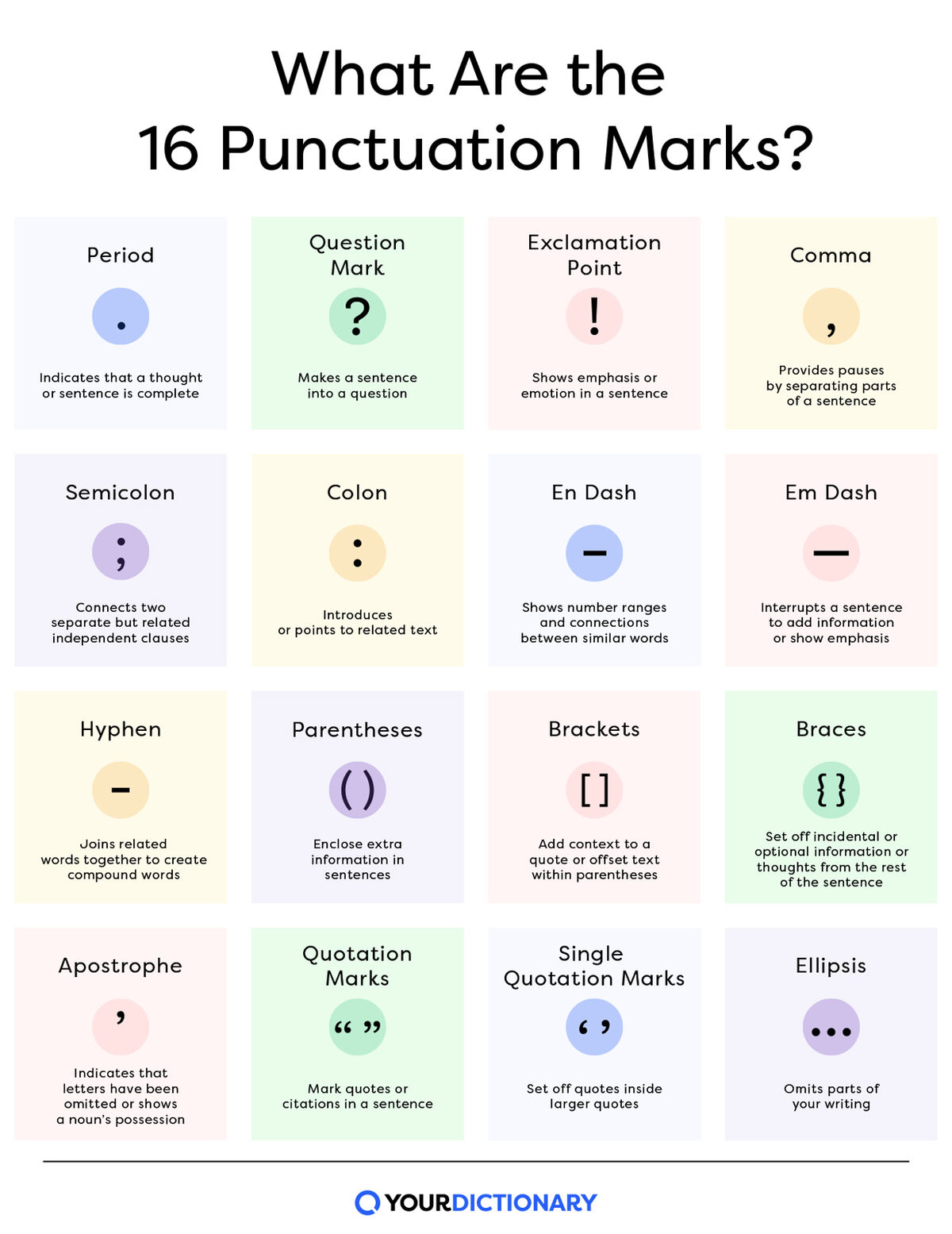
In English, there are 16 punctuation marks — the period, question mark, exclamation point, comma, semicolon, colon, em dash, en dash, hyphen, parentheses, brackets, braces, apostrophe, double quotation marks, single quotation marks, and ellipsis — and they’re not as scary as they sound.
Each punctuation mark has a specific use and purpose in a sentence's structure.
Period ( . )
The . is called a period. The period actually serves two purposes in grammar.
When it appears at the end of a declarative sentence, it ends the sentence. The period can also indicate that a word is an abbreviation.
- As a sentence ender - Jane and Jack went to the market.
- After an abbreviation - John Jones Jr. was born on Dec. 6, 2008.
Question Mark ( ? )
The ? is called a question mark. Question marks ask direct questions, which are also known as interrogative sentences. They can also express confusion.
- Interrogative sentence - When did Jane leave for the market?
- Expressing confusion - Why do we have so much homework?
Exclamation Point ( ! )
The ! is called an exclamation point. Exclamation points are punctuation marks that show a sudden outcry in writing.
They also emphasize a point more strongly than a period.
- Sudden outcry - "Holy cow!" screamed Jane.
- To emphasize a point - My mother-in-law's rants make me furious!
Comma ( , )
The , is called a comma. Commas separate ideas or elements within the structure of a sentence. They also appear in numbers, dates, and letter writing after the salutation and closing.
- Direct address - Thanks for all your help, John.
- Separating two complete sentences - We went to the movies, and then we went out to lunch.
- Separating elements in a list - Suzi wanted the black, green, and blue dress.
Quick Tip
The final comma in a list, known as an Oxford or serial comma, is optional. Some style guides prefer it, while others consider it unnecessary.
An Oxford comma is always necessary when the sentence is confusing without it.
Semicolon ( ; )
The ; is called a semicolon.
Semicolons are punctuation marks that connect independent clauses to show a closer relationship between the clauses than a period would. They can also separate items in a list that already include commas.
- Connecting independent clauses - John was hurt; he knew she only said it to upset him.
- Items in a list - I’ve visited Cleveland, Ohio; Los Angeles, California; and St. Louis, Missouri.
Colon ( : )
The : is called a colon. Colons introduce a quotation, an explanation, an example, or a series. They can also clarify information or emphasize an important word or phrase.
- Introducing a series - He was planning to study four subjects: politics, philosophy, sociology, and economics.
- Clarifying information - I didn't have time to get changed: I was already late.
- Emphasizing an important phrase - There was one thing she loved more than any other: her dog.
Em Dash ( — )
The — is called an em dash. Em dashes set off information from the rest of the sentence. They can also show emphasis to a word or phrase.
You can add spaces to either side of an em dash, depending on your style guide.
- Setting off information - My best friend — whom I’ve known since I was a kid — is moving away.
- Showing emphasis - The house was beautiful — but haunted.
En Dash ( – )
The – is called an en dash. En dashes are shorter than em dashes, and they indicate a range or connection between numbers or words.
You don’t need to use spaces on either side of an en dash.
- Indicating range - The Civil War (1861–1865) made a lasting impact in the United States.
- Indicating connection - When does the Denver–Dallas flight arrive?
Hyphen ( - )
The - is called a hyphen. Hyphens are even shorter than en dashes. They join two or more words together to make compound nouns, compound adjectives, and compound numbers.
- Compound noun - My sister-in-law works as a pastry chef.
- Compound adjective - The well-known author signed autographs for his fans.
- Compound number - Cory can count all the way to ninety-nine.
Parentheses ( )
The ( ) are called parentheses.
Parentheses add further thoughts or qualifying remarks to a sentence. They separate these phrases from the rest of the sentence.
- Further thought - John and Jane (who are brother and sister) both have red hair.
- Qualifying remarks - Add any special skills (typing, organization, training, and so on) to your resume.
Brackets [ ]
The [ ] are called brackets. Brackets clarify meaning in a quote by adding words or the phrase sic. They also form parenthetical statements inside larger parenthetical statements (called nesting parentheses).
- Adding words to a quote - “He [Mr. Jones] was the last person seen at the house,” reported the detective.
- Adding sic to a quote - “Our team issues no further statments [sic] at this time.”
- Nesting parentheses - We decided to go to the Grand Canyon (my [childhood] dream) this summer.
Braces { }
The { } are called braces. Braces contain sets of numerical or specialized information to show that they are considered as a unit.
You won’t often see braces in writing, but you’ll see them around groups of numbers and mathematical expressions.
- Grouping numbers - The teacher wrote a set of numbers {6, 9, 12} on the board.
- Mathematical expression - (2{1+[23-3]}=x)
Apostrophe ( ‘ )
The ' is called an apostrophe.
Apostrophes are punctuation marks that indicate the omission of a letter or letters from a word.
They form contractions, show the possessive case, or create plurals of lowercase letters.
- Contractions - I've seen that movie several times.
- Possessive case - Sara’s dog bit the neighbor.
- Plural for lowercase letters - Mind your p's and q's.
Quotation Marks (“ ”)
The " " are called quotation marks (or double quotation marks). Quotation marks indicate the beginning and end of a quoted passage. They can also show dialogue in fiction.
- Quoted passage - Nathan Hale’s last words were, “I regret that I have but one life to live for my country.”
- Dialogue - "Don't go outside," Katie said.
Single Quotation Marks (‘ ’)
The ' ' are called single quotation marks (or single quotes). Single quotation marks show quotes within a quotation, and they set off quotes in headlines.
- Quotes within quotations - Marie told the teacher, "Marc said to me 'Bill started the fight,' and I believed him."
- Quotes in headlines - President Declares, ‘War Is Over’
Ellipsis (...)
The .... is called an ellipsis. An ellipsis indicates an omission of words or sentences.
Students writing research papers or newspapers quoting parts of speeches will often employ ellipsis to avoid copying lengthy text that is not needed.
- Omission of words - She began to count, "One, two, three, four…" until she got to 10, then went to find him.
- Within a quotation - When Newton stated, "An object at rest stays at rest and an object in motion stays in motion..." he developed the law of motion.
Punctuation Marks Reference Poster
If you need a handy reference guide to the 16 punctuation marks, print or share the poster below.

British vs. American English Punctuation
There are a few differences between punctuation marks names in British and American English. The following chart details some of those differences.
|
British English |
American English |
|
|
The . symbol is called |
a full stop |
a period |
|
The ! symbol is called |
an exclamation mark |
an exclamation point |
|
The ( ) symbols are called |
brackets |
parentheses |
|
The [ ] symbols are called |
square brackets |
brackets |